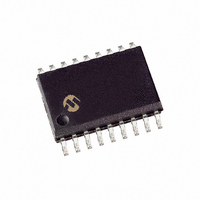MCP2515-I/SO Microchip Technology, MCP2515-I/SO Datasheet - Page 8

MCP2515-I/SO
Manufacturer Part Number
MCP2515-I/SO
Description
IC CAN CONTROLLER W/SPI 18SOIC
Manufacturer
Microchip Technology
Specifications of MCP2515-I/SO
Package / Case
18-SOIC (7.5mm Width)
Controller Type
CAN Interface
Interface
SPI
Voltage - Supply
2.7 V ~ 5.5 V
Current - Supply
10mA
Operating Temperature
-40°C ~ 85°C
Mounting Type
Surface Mount
Product
Controller Area Network (CAN)
Number Of Transceivers
1
Data Rate
1 Mbps
Supply Voltage (max)
5.5 V
Supply Voltage (min)
2.7 V
Supply Current (max)
10 mA
Maximum Operating Temperature
+ 85 C
Minimum Operating Temperature
- 40 C
Mounting Style
SMD/SMT
Supply Voltage Range
2.7V To 5.5V
Driver Case Style
SOIC
No. Of Pins
18
Operating Temperature Range
-40°C To +85°C
Filter Terminals
SMD
Supply Voltage Min
2.7V
Rohs Compliant
Yes
Clock Frequency
40MHz
Lead Free Status / RoHS Status
Lead free / RoHS Compliant
For Use With
MCP2515DM-BM - BOARD DEMO FOR MCP2515/51MCP2515DM-PTPLS - BOARD DAUGHTER PICTAIL MCP2515MCP2515DM-PCTL - BOARD DEMO FOR MCP2515DV251001 - KIT DEVELOPMENT CAN MCP2510
Lead Free Status / Rohs Status
Lead free / RoHS Compliant
Available stocks
Company
Part Number
Manufacturer
Quantity
Price
Company:
Part Number:
MCP2515-I/SO
Manufacturer:
TI
Quantity:
1 000
Part Number:
MCP2515-I/SO
Manufacturer:
MICROCHIP/微芯
Quantity:
20 000
MCP2515
2.4.1
If an error-active node detects a bus error, the node
interrupts transmission of the current message by
generating an active error flag. The active error flag is
composed of six consecutive dominant bits. This bit
sequence actively violates the bit-stuffing rule. All other
stations recognize the resulting bit-stuffing error and, in
turn, generate error frames themselves, called error
echo flags.
The error flag field, therefore, consists of between six
and twelve consecutive dominant bits (generated by
one or more nodes). The error delimiter field (eight
recessive bits) completes the error frame. Upon
completion of the error frame, bus activity returns to
normal and the interrupted node attempts to resend the
aborted message.
2.4.2
If an error-passive node detects a bus error, the node
transmits an error-passive flag followed by the error
delimiter field. The error-passive flag consists of six
consecutive recessive bits. The error frame for an error-
passive node consists of 14 recessive bits. From this, it
follows that unless the bus error is detected by an error-
active node or the transmitting node, the message will
continue transmission because the error-passive flag
does not interfere with the bus.
If the transmitting node generates an error-passive flag,
it will cause other nodes to generate error frames due to
the resulting bit-stuffing violation. After transmission of
an error frame, an error-passive node must wait for six
consecutive recessive bits on the bus before attempting
to rejoin bus communications.
The error delimiter consists of eight recessive bits, and
allows the bus nodes to restart bus communications
cleanly after an error has occurred.
DS21801F-page 8
Note:
ACTIVE ERRORS
Error echo flags typically occur when a
localized disturbance causes one or more
(but not all) nodes to send an error flag.
The remaining nodes generate error flags
in response (echo) to the original error
flag.
PASSIVE ERRORS
2.5
An overload frame, shown in
format as an active-error frame. An overload frame,
however, can only be generated during an interframe
space. In this way, an overload frame can be
differentiated from an error frame (an error frame is
sent during the transmission of a message). The
overload frame consists of two fields: an overload flag
followed by an overload delimiter. The overload flag
consists of six dominant bits followed by overload flags
generated by other nodes (and, as for an active error
flag, giving a maximum of twelve dominant bits). The
overload delimiter consists of eight recessive bits. An
overload frame can be generated by a node as a result
of two conditions:
1.
2.
2.6
The interframe space separates a preceding frame (of
any type) from a subsequent data or remote frame.
The interframe space is composed of at least three
recessive bits called the Intermission. This allows
nodes time for internal processing before the start of
the next message frame. After the intermission, the
bus line remains in the recessive state (bus idle) until
the next transmission starts.
Note:
The node detects a dominant bit during the
interframe
Exception: The dominant bit is detected during
the third bit of IFS. In this case, the receivers will
interpret this as a SOF.
Due to internal conditions, the node is not yet
able to begin reception of the next message. A
node may generate a maximum of two
sequential overload frames to delay the start of
the next message.
Overload Frame
Interframe Space
Case 2 should never occur with the
MCP2515 due to very short internal
delays.
space,
© 2010 Microchip Technology Inc.
an
Figure
illegal
2-5, has the same
condition.
















